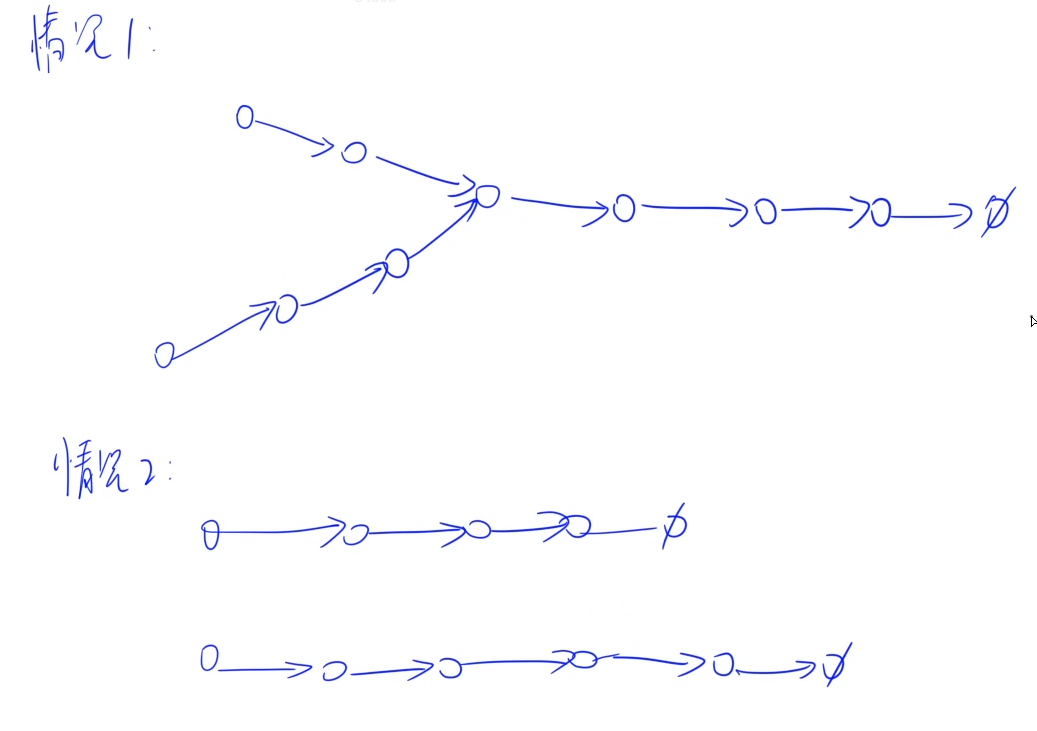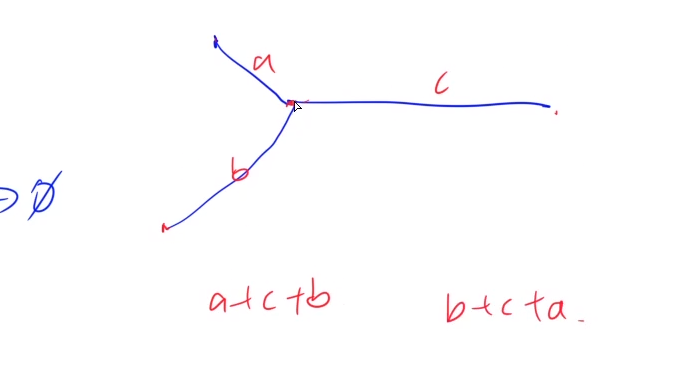1.acwing.66.两个链表的第一个公共结点
这几道链表题大多来自《剑指offer》,都不太会啊!
输入两个链表,找出它们的第一个公共结点。
当不存在公共结点时,返回空结点。
样例
1
2
3
4
5
6
7
8
| 给出两个链表如下所示:
A: a1 → a2
↘
c1 → c2 → c3
↗
B: b1 → b2 → b3
输出第一个公共结点c1
|


1
2
3
4
5
6
7
8
9
10
11
12
13
14
| class Solution {
public:
ListNode *findFirstCommonNode(ListNode *headA, ListNode *headB) {
ListNode* p = headA;ListNode* q = headB;
while (p != q)
{
if (p) p = p->next;
else p = headB;
if (q) q = q->next;
else q = headA;
}
return p;
}
};
|
2.acwing.29.删除链表中的重复结点
在一个排序的链表中,存在重复的结点,请删除该链表中重复的结点,重复的结点不保留。
样例11
1
2
3
| 输入:1->2->3->3->4->4->5
输出:1->2->5
|
样例2
1
2
3
| 输入:1->1->1->2->3
输出:2->3
|
算法:(线性扫描) O(n)
为了方便处理边界情况,我们定义一个虚拟元素 dummy指向链表头节点。
然后从前往后扫描整个链表,每次扫描元素相同的一段,如果这段中的元素个数多于1个,则将整段元素直接删除。
时间复杂度
整个链表只扫描一遍,所以时间复杂度是 O(n)。
1
2
3
4
5
6
7
8
9
10
11
12
13
14
15
16
| class Solution {
public:
ListNode* deleteDuplication(ListNode* head) {
ListNode* dummy = new ListNode(-1);
dummy->next = head;
ListNode* p = dummy;
while (p->next)
{
auto q = p->next;
while (q->next && p->next->val == q->next->val) q = q->next;
if (p->next == q) p = q;
else p->next = q->next;
}
return dummy->next;
}
};
|
3.C++ STL容器
STL是提高C++编写效率的一个利器。 ——yxc
最后两章要背的东西比较多!
3.1 #include <vector>
vector是变长数组,支持随机访问,不支持在任意位置O(1)插入。为了保证效率,元素的增删一般应该在末尾进行。
3.1.1 声明
1
2
3
4
5
6
7
8
9
| #include <vector> 头文件
vector<int> a; 相当于一个长度动态变化的int数组
vector<int> b[233]; 相当于第一维长233,第二位长度动态变化的int数组
struct rec{…};
vector<rec> c; 自定义的结构体类型也可以保存在vector中
|
3.1.2 size/empty
size函数返回vector的实际长度(包含的元素个数),empty函数返回一个bool类型,表明vector是否为空,为空返回true,否则返回false。二者的时间复杂度都是O(1)。
所有的STL容器都支持这两个方法,含义也相同,之后我们就不再重复给出。
3.1.3 clear
clear函数把vector清空。
3.1.4 迭代器(iterator)
迭代器就像STL容器的“指针”,可以用星号“*”操作符解除引用。
一个保存int的vector的迭代器声明方法为:
vector<int>::iterator it;
vector的迭代器是“随机访问迭代器”,可以把vector的迭代器与一个整数相加减,其行为和指针的移动类似。可以把vector的两个迭代器相减,其结果也和指针相减类似,得到两个迭代器对应下标之间的距离。
3.1.5 begin/end–[begin,end)
begin函数返回指向vector中第一个元素的迭代器。例如a是一个非空的vector,则*a.begin()与a[0]的作用相同。
所有的容器都可以视作一个“前闭后开”的结构,end函数返回vector的尾部,即第n个元素再往后的“边界”。*a.end()与a[n]都是越界访问,其中n=a.size()。
下面两份代码都遍历了vector<int> a,并输出它的所有元素。
1
2
3
| for (int I = 0; I < a.size(); I ++) cout << a[i] << endl;
for (vector<int>::iterator it = a.begin(); it != a.end(); it ++) cout << *it << endl;
|
3.1.6 front/back
front函数返回vector的第一个元素,等价于*a.begin() 和 a[0]。
back函数返回vector的最后一个元素,等价于*==a.end() 和 a[a.size() – 1]。
3.1.7 push_back() 和 pop_back()
a.push_back(x) 把元素x插入到vector a的尾部。
在数组结尾插入时间复杂度是O(1),在数组开头插入时间复杂度是O(n)。
b.pop_back() 删除vector a的最后一个元素。
3.1.8 实例
1
2
3
4
5
6
7
8
9
10
11
12
13
14
15
16
17
18
19
20
21
22
23
24
25
26
27
28
29
30
31
| #include <iostream>
#include <vector>
using namespace std;
int main()
{
vector<int> a{{1,2,3}};
cout << a.front() << ' ' << a[0] << ' ' << *a.begin() << endl;
cout << a.back() << ' ' << a[a.size()-1] << endl;
for (int i = 0;i < a.size();i ++) cout << a[i] << ' ';
cout << endl;
for (vector<int>::iterator it = a.begin();it != a.end();it ++) cout << *it << ' ';
cout << endl;
for (int x : a) cout << x << ' ';
cout << endl;
a.push_back(4);
for (auto x:a) cout << x << ' ';
cout << endl;
a.pop_back();
for (auto x:a) cout << x << ' ';
cout << endl;
return 0;
}
|
3.2 #include <queue>
头文件queue主要包括循环队列queue和优先队列priority_queue两个容器。
没有clear函数。
先进先出(FIFO),队头插入,队尾删除。
优先队列:
- 定义大根堆时结构体要重载小于号<;
- 定义小根堆时结构体要重载大于号>;
3.2.1 声明
1
2
3
4
5
6
7
8
9
| queue<int> q;
struct rec{…}; queue<rec> q;
priority_queue<int> q;
priority_queue<int, vector<int>, greater<int>> q;
priority_queue<pair<int, int>> q;
|
3.2.2 循环队列 queue
push 从队尾插入
pop 从队头弹出
front 返回队头元素
back 返回队尾元素
3.2.3 优先队列 priority_queue
push 把元素插入堆
pop 删除堆顶元素
top 查询堆顶元素(最大值)
3.2.4 实例
1
2
3
4
5
6
7
8
9
10
11
12
13
14
15
16
17
18
19
20
21
22
23
24
25
26
27
28
29
30
31
32
33
34
35
36
37
38
39
40
41
42
43
44
45
46
47
48
49
50
51
52
| #include <iostream>
#include <vector>
#include <queue>
using namespace std;
int main()
{
queue<int> a;
a.push(1);
a.push(2);
a.push(3);
a.pop();
cout << a.front() << endl;
cout << a.back() << endl;
a = queue<int>();
queue<double> q;
priority_queue<int> b;
b.push(2);
b.push(4);
b.push(8);
cout << b.top() << endl;
b.pop();
cout << b.top() << endl;
priority_queue<int,vector<int>,greater<int>> x;
struct Rec
{
int a,b;
bool operator< (const Rec& t) const
{
return a < t.a;
}
};
priority_queue<Rec> s;
s.push({1,2});
struct Res
{
int a,b;
bool operator> (const Res& t) const
{
return a > t.a;
}
};
priority_queue<Res,vector<Res>,greater<Res>> n;
n.push({1,2});
queue<Rec> v;
v.push({1});
return 0;
}
|
3.3 #include <stack>
头文件stack包含栈。声明和前面的容器类似。
没有clear函数。
先进后出(FILO),栈顶插入,栈顶删除
push 向栈顶插入
pop 弹出栈顶元素
top 取栈顶元素
1
2
3
4
5
6
7
8
9
10
11
12
13
14
15
16
17
| #include <iostream>
#include <stack>
using namespace std;
int main()
{
stack<int> stk;
stk.push(1);
stk.push(8);
cout << stk.top() << endl;
stk.pop();
stk.push(12);
cout << stk.top() << endl;
return 0;
}
|
3.4 #include <deque>
双端队列deque是一个支持在两端高效插入或删除元素的连续线性存储空间。它就像是vector和queue的结合。与vector相比,deque在头部增删元素仅需要O(1)的时间;与queue相比,deque像数组一样支持随机访问。运行效率会比stack和vector慢。
[] 随机访问
begin/end,返回deque的头/尾迭代器,左闭右开
front/back 队头/队尾元素
push_back 从队尾入队
push_front 从队头入队
pop_back 从队尾出队
pop_front 从队头出队
clear 清空队列
1
2
3
4
5
6
7
8
9
10
11
12
13
14
15
16
17
18
19
| #include <iostream>
#include <deque>
using namespace std;
int main()
{
deque<int> a;
a.push_back(1),a.push_front(2);
a.push_back(3);
cout << *a.begin() << ' ' << *a.end() << endl;
cout << a.front() << ' ' << a.back() << endl;
cout << a[0] << ' ' << a[2] << endl;
a.pop_back(),a.pop_front();
a.clear();
return 0;
}
|



